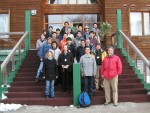Joint watersheds workshop brings U.S. and Japanese scientists together in Hokkaido, Japan
A joint workshop on Biogeochemistry and Hydrology of Forested Watersheds associated with ILTER was held by U.S. and Japanese scientists March 14-18, 2005 in Hokkaido, Japan. The workshop had three aims:
- Facilitate the exchange of current research results, emphasizing long-term data collection, among U.S. and Japanese scientists
- Stimulate further collaborative research between the two groups
- Facilitate further development of the Japanese ILTER Network
The workshop was funded by the Japanese Society for the Promotion of Science (JSPS). U.S. scientists were funded by a National Science Foundation supplement to the Hubbard Brook LTER. Workshop participants (22 Japanese and eight U.S.) first gathered at the Uryu Experimental Forest (Hokkaido University) in northern Hokkaido—a region characterized by extensive snow (over two meters) and very cold temperatures (-41 Celsius) in winter.
Hideaki Shibata (Hokkaido University) opened the workshop with an overview of on-going research in the cool-temperate watersheds of Hokkaido, followed by a poster session during which Japanese and U.S. scientists shared research results on a wide variety of hydrological and biogeochemical topics. The next day participants took a field excursion to Uryu Experimental Forest. After an overview of the research site by the Director, Toshiya Yoshida, the group used skis, snowshoes, and snow caterpillars to reach the potential ILTER experimental sites.
Among U.S. presenters, Sheila Christopher discussed her current research, which is sponsored by a JSPS Postdoctoral Fellowship. Afterwards, Rick Hooper (Consortium of Universities for the Advancement of Hydrologic Science, Inc.) presented a case study of successful large-scale collaborative hydrologic research among U.S. universities, and a round-table discussion led by Nobu Ohte (Kyoto University) and Steve Hamburg (Brown University) focused on the similarities and differences between U.S. and Japanese watersheds.
The next day the group traveled south by bus and aircraft to Seto City and toured Aichi Experimental Forest (University of Tokyo) on Honshu, Japan’s main island. Hirofumi Shibano, Director of the experimental forest, led a field excursion to Shirasaka watershed, another potential Japanese ILTER site with a long history of hydrological monitoring. Later, Charley Driscoll (Syracuse University) gave an overview of the Hubbard Brook LTER site, emphasizing the importance of long-term research. Myron Mitchell (SUNY Environmental Science and Forestry) and Hideaki Shibata then led the group in a very productive discussion on major issues related to hydrological and biogeochemical research in Japan. The issues were divided into five categories:
- Spatial scaling
- Riparian zones
- Climate change and global warming
- Disturbance and land use
- Nutrient limitation
Workshop organizers and participants are compiling these ideas into a report that will be used to develop future proposals to cover research not only in Japan, but throughout East Asia. These ideas will be discussed further at the next meeting of the East Asia and Pacific regional ILTER scheduled for March 2006 in Japan.
Sheila F. Christopher, JSPS Postdoctoral fellow
Field Science Center for the Northern Biosphere, Hokkaido University, Japan

 Enlarge this image
Enlarge this image